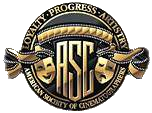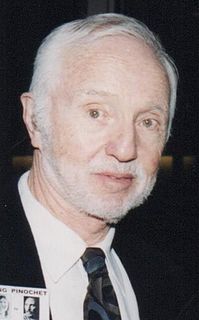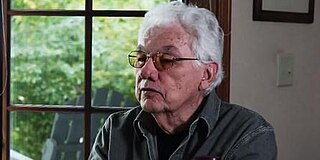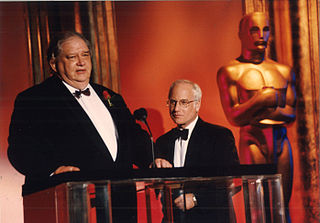Related Research Articles

Cinematography is the art of motion picture photography.

Steadicam is a brand of camera stabilizer mounts for motion picture cameras invented by Garrett Brown and introduced in 1975 by Cinema Products Corporation. It mechanically isolates the camera from the operator's movement, allowing for a smooth shot, even when the operator moves over an irregular surface.

Sidney Arthur Lumet was an American film director, producer, and screenwriter with over 50 films to his credit. He was nominated five times for the Academy Award: four for Best Director for 12 Angry Men (1957), Dog Day Afternoon (1975), Network (1976), and The Verdict (1982) and one for Best Adapted Screenplay for Prince of the City (1981). He did not win an individual Academy Award, but did receive an Academy Honorary Award, and 14 of his films were nominated for Oscars.

The American Society of Cinematographers (ASC), founded in Hollywood in 1919, is a cultural, educational, and professional organization that is neither a labor union nor a guild. The society was organized to advance the science and art of cinematography and gather a wide range of cinematographers to discuss techniques and ideas and to advocate for motion pictures as a type of art form. Currently, the president of the ASC is Stephen Lighthill.
Garrett Brown is an American inventor, best known as the creator of the Steadicam. Brown's invention allows camera operators to film while walking without the normal shaking and jostles of a handheld camera. The Steadicam was first used in the Hal Ashby film Bound for Glory (1976), receiving an Academy Award, and since used on such films as Rocky, filming Rocky's running and training sequences, and Return of the Jedi, where Brown walked through a Redwood forest with the Steadicam shooting film at 1 frame per second to achieve the illusion of high speed motion during the speeder-bike chase.

Vilmos ZsigmondASC was a Hungarian-American cinematographer. His work in cinematography helped shape the look of American movies in the 1970s, making him one of the leading figures in the American New Wave movement.

Panavision is an American motion picture equipment company founded in 1953 specializing in cameras and lenses, based in Woodland Hills, California. Formed by Robert Gottschalk as a small partnership to create anamorphic projection lenses during the widescreen boom in the 1950s, Panavision expanded its product lines to meet the demands of modern filmmakers. The company introduced its first products in 1954. Originally a provider of CinemaScope accessories, the company's line of anamorphic widescreen lenses soon became the industry leader. In 1972, Panavision helped revolutionize filmmaking with the lightweight Panaflex 35 mm movie camera. The company has introduced other cameras such as the Millennium XL (1999) and the digital video Genesis (2004).

Wong Tung Jim, A.S.C., known professionally as James Wong Howe (Houghto), was a Chinese-born American cinematographer who worked on over 130 films. During the 1930s and 1940s, he was one of the most sought after cinematographers in Hollywood due to his innovative filming techniques. Howe was known as a master of the use of shadow and one of the first to use deep-focus cinematography, in which both foreground and distant planes remain in focus.

Haskell Wexler, ASC was an American cinematographer, film producer, and director. Wexler was judged to be one of film history's ten most influential cinematographers in a survey of the members of the International Cinematographers Guild. He won the Academy Award for Best Cinematography twice, in 1966 and 1976 in five nominations.

Gordon Hugh Willis Jr., ASC was an American cinematographer and film director. He is best known for his photographic work on eight Woody Allen films, six Alan J. Pakula films, four James Bridges films, and all three films from Francis Ford Coppola's The Godfather series.
Dean Raymond Cundey, A.S.C. is an American cinematographer and film director. He is known for his collaborations with John Carpenter, Steven Spielberg, Robert Zemeckis, as well as his extensive work in the horror genre, in addition to numerous family and comedy films. He was nominated for an Academy Award for Best Cinematography for his work on Who Framed Roger Rabbit and has been nominated for numerous BAFTAs and BSC Awards.
Walter C. Pfister is an American director and retired cinematographer, who is best known for his work with acclaimed filmmaker Christopher Nolan. Some of his collaborations with Nolan include Memento (2000), The Dark Knight Trilogy (2005–2012), and Inception (2010). For his work on Inception, Pfister won an Academy Award for Best Cinematography and received a BAFTA Award nomination.
Jessica Lingmin Yu is an American film director, writer, producer, and editor. She has directed documentary films, dramatic films, and television shows.
Emmanuel Lubezki Morgenstern is a Mexican cinematographer. He sometimes goes by the nickname Chivo, which means "goat" in Spanish. Lubezki has worked with many acclaimed directors, including Mike Nichols, Tim Burton, Michael Mann, Joel and Ethan Coen, and frequent collaborators Terrence Malick, Alfonso Cuarón, and Alejandro González Iñárritu.
Wilmer C. "Bill" Butler, ASC is an American cinematographer. He shot The Conversation (1974), Jaws (1975), and three Rocky sequels. He completed 1975's One Flew Over the Cuckoo's Nest after Haskell Wexler was fired from the production, and was subsequently nominated for an Academy Award for Best Cinematography. He became a centenarian in April 2021.

Thomas George Hooper is a British-Australian film and television director and producer.
John Newton Green, ASC, is an American cinematographer and film director best known for his Oscar-nominated collaborations with actor/director Clint Eastwood, taking over from Eastwood's previous collaborator Bruce Surtees.

Apurba Kishore Bir, also known as A. K. Bir, is an Indian film cinematographer, screenwriter and director. An alumnus of the Film and Television Institute of India, Pune, he worked in various Ad-films and documentaries before making his feature-film debut. He won the National Film Award for Best Cinematography for 27 Down, his debut film. His directional debut Aadi Mimansa won the Nargis Dutt Award for Best Feature Film on National Integration. Bir's other directional ventures Lavanya Preeti and Baaja were bestowed with the National Film Award for Best Children's Film. As of 2014, he has won nine National Film Awards—including three for Best Cinematography—and is one of the directors of National Film Development Corporation of India.

Peter Denz is a German engineer, inventor, entrepreneur and Oscar winner.
Peter Hannan is an Australian cinematographer who spent the majority of his career in Great Britain.
References
- ↑ Metzer, Marla (14 June 1997). "Capturing a Fido's Eye View of the Big Screen". Los Angeles Times.
- ↑ Phillips, Michael (27 December 2006). "Children of Men director thrives on collaboration". Chicago Tribune.
- ↑ Healy, Donna (2009-03-14). "Capturing the action". Mtstandard.com. Retrieved 2012-05-30.
- ↑ "Doggicam Systems". Doggicam.com. Retrieved 2012-05-30.
- ↑ Tim Tyler (2006-02-13). "Gary Thieltges to receive Academy Award for Technical Achievement". Cinematography.com. Retrieved 2012-05-30.
- ↑ "Session Timeout - Academy Awards® Database - AMPAS". Awardsdatabase.oscars.org. 2010-01-29. Retrieved 2012-05-30.